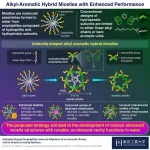(Press-News.org) Columbia Engineers use nuclear magnetic resonance spectroscopy to examine lithium metal batteries through a new lens -- their findings may help them design new electrolytes and anode surfaces for high-performance batteries
New York, NY—May 20, 2024—A Columbia Engineering team has published a paper in the journal Joule today that details how nuclear magnetic resonance spectroscopy techniques can be leveraged to design the anode surface in lithium metal batteries. The researchers also present new data and interpretations for how this method can be used to gain unique insight into the structure of these surfaces to share with the field.
“We believe that, armed with all the data we’ve pulled together, we can help accelerate the design of lithium metal batteries and help make them safe for consumers, which folks have been trying to do for more than four decades,” said the team’s leader Lauren Marbella, associate professor of chemical engineering.
The promise of lithium metal batteries
Batteries that use a lithium metal anode instead of a graphite anode, like the ones used in our cell phones and electric vehicles, will enable more affordable and versatile electrified modes of transportation, including semi-trucks and small aircraft. For example, the price of electric vehicle batteries would decrease while simultaneously offering a longer range (from 400 km to >600 km).
Why they’re hard to commercialize
But commercializing lithium metal batteries is still far off in the future. Lithium metal is one of the most reactive elements on the periodic table and readily develops a passivation layer that impacts the structure of the anode itself during normal battery use. This passivation layer is like the layer that develops when silverware or jewelry begins to tarnish, but because lithium is so reactive, the lithium metal anode in a battery will begin to “tarnish” as soon as it touches the electrolyte.
The chemistry of the passivation layer impacts how lithium ions move during battery charging/discharging, ultimately impacting whether or not metal filaments that lead to poor battery performance grow inside of the system. Up to now, measuring the chemical composition of the passivation layer, known by the battery community as the solid electrolyte interphase (SEI), while simultaneously capturing information on how lithium ions located in that layer are moving around has been next to impossible.
Marbella noted, “If we had this information, we could start to draw connections to specific SEI structures and properties that lead to high-performance batteries.”
Insights from the new study
The Joule study distills recent research, much of which the Marbella group has led or contributed to, to present a case to leverage nuclear magnetic resonance (NMR) spectroscopy methods to connect the structure of the passivation layer on lithium to its actual function in the battery.
NMR enables researchers to directly probe how fast lithium ions move at the interface between the lithium metal anode and its passivation layer, while also providing a readout of the chemical compounds that are present on that surface. While other characterization methods, like electron microscopy, may provide striking images of the SEI layer on the surface of lithium metal, they cannot pinpoint the exact chemical composition of disordered species, nor can they “see” ion transport. Other techniques that can probe lithium transport across the interface, like electrochemical analyses, do not provide chemical information.
Examining the data collected in Marbella’s laboratory over the past six years, the team has found that NMR can uniquely sense changes in the structure of compounds in the SEI on lithium metal, which is key to explaining some of its more elusive structure-property relationships. The researchers believe that combining multiple techniques, like NMR, other spectroscopies, microscopy, computer simulations, and electrochemical methods, will be necessary to develop and advance the development of lithium metal batteries.
Applying NMR methods unveils new insights
When researchers expose lithium metal to different electrolytes, they often observe different performance metrics. Marbella’s NMR experiment shows that these changes in performance arise because different electrolyte compositions create distinct SEI compositions and deliver lithium ions to the anode surface at different rates. Specifically, when lithium metal battery performance improves, the rate of lithium exchange with the surface increases. They can now also see how the passivation layer should be arranged. To achieve the best performance, different chemical compounds must be layered on top of one another in the SEI, rather than randomly distributed.
The exchange experiments demonstrated in the new study can be used by materials scientists to help screen electrolyte formulations for high-performance lithium metal batteries as well as identify the surface compounds in the SEI that are required for high performance. Marbella adds that NMR is one of the only techniques -- if not the only -- that can probe the local structural changes of compounds in the SEI to address how ionically insulating materials may enable fast lithium-ion transport in the SEI. “Once we know what structural changes are occurring -- for instance, are things like lithium fluoride becoming amorphous, defected, nano-sized -- then we can intentionally engineer these in and design lithium metal batteries that meet the performance metrics required for commercialization. The NMR experiment is one of the few that can accomplish this task and give us the very information essential to pushing anode surface design forward.”
Looking ahead
Marbella’s group is currently using exchange NMR coupled with electrochemistry to provide a deeper understanding of SEI composition and properties in different electrolytes for lithium metal batteries. They are also developing systems that can determine individual chemical components’ role in lithium-ion transport through the SEI.
About the Study
Journal: Joule
The study is titled “Using NMR spectroscopy to link structure to function at the Li solid electrolyte interphase.”
Authors are: Asya Svirinovsky-Arbeli1, Mikkel Juelsholt1, Richard May2, Yongbeom Kwon1, Lauren E. Marbella1*
1Department of Chemical Engineering, Columbia University
2Department of Earth & Environmental Engineering, Columbia University
The study was supported by the National Science Foundation (NSF) CAREER Award (CBET-2045262) and the Research Corporation for Science Advancement through a Cottrell Scholar Award (28206). A. S.-A. is supported by the Columbia Climate School Postdoctoral Research Program at Columbia University. M. J. is supported by the Carlsberg Foundation, grant CF22-0367.
The authors declare no financial or other conflicts of interest.
###
END
Using magnetic resonance spectroscopy to design safer, higher-performance lithium batteries
Columbia Engineers use nuclear magnetic resonance spectroscopy to examine lithium metal batteries through a new lens -- their findings may help them design new electrolytes and anode surfaces for high-performance batteries
2024-05-20
ELSE PRESS RELEASES FROM THIS DATE:
Should your exercise goals be in minutes or steps? Study suggests they are equally beneficial
2024-05-20
In the age of smartwatches, monitoring step counts has never been easier, but current physical activity guidelines do not explicitly recommend specific step counts for health. A new study from researchers at Brigham and Women’s Hospital, a founding member of Mass General Brigham, suggests that both step and time-based exercise targets are equivalently associated with lower risks of early death and cardiovascular disease. Thus, whether one chooses a time or step goal may not be as important as choosing a goal aligned with personal preferences. Results are published in JAMA Internal Medicine.
Physical activity reduces the risk of acquiring chronic illness and ...
Racial and ethnic inequities in cancer care continuity during the COVID-19 pandemic among those with SARS-CoV-2
2024-05-20
About The Study: In this cross-sectional study of patients with cancer and SARS-CoV-2, racial and ethnic inequities existed in treatment delays and discontinuations throughout the pandemic; however, the disproportionate burden among racially and ethnically minoritized patients with cancer varied across SARS-CoV-2 waves. These inequities may lead to downstream adverse impacts on cancer mortality among minoritized adults in the United States.
Corresponding Author: To contact the corresponding author, Jessica Y. Islam, Ph.D., M.P.H., email jessica.islam@moffitt.org.
To access the embargoed study: Visit our For The Media website at this link https://media.jamanetwork.com/
(doi:10.1001/jamanetworkopen.2024.12050)
Editor’s ...
Effect of sleep restriction on adolescent cognition by adiposity
2024-05-20
About The Study: Adolescents with overweight or obesity may be more vulnerable to negative cognitive effects following sleep restriction. Improved sleep hygiene and duration in this group may positively impact their cognitive health.
Corresponding Author: To contact the corresponding author, Aaron D. Fobian, Ph.D., email afobian@uabmc.edu.
To access the embargoed study: Visit our For The Media website at this link https://media.jamanetwork.com/
(doi:10.1001/jamaneurol.2024.1332)
Editor’s ...
Webb Telescope offers first glimpse of an exoplanet’s interior
2024-05-20
A surprisingly low amount of methane and a super-sized core hide within the cotton candy–like planet WASP-107 b.
The revelations, based on data obtained by the James Webb Space Telescope, mark the first measurements of an exoplanet’s core mass and will likely underpin future studies of planetary atmospheres and interiors, a key aspect in the search for habitable worlds beyond our solar system.
“Looking into the interior of a planet hundreds of light-years away sounds almost impossible, but when you know the mass, radius, atmospheric composition, and hotness of its interior, you’ve got ...
Alkyl-aromatic hybrid micelles formed from emergent umbrella-shaped molecules
2024-05-20
Micelles assemble in water from amphiphilic molecules, composed of hydrophilic and hydrophobic frameworks. They can be found all around us, for example in soaps, detergents, and shampoos. Their main application is the water-solubilization of insoluble molecules through encapsulation into hydrophobic cavities. These cavities are conventionally composed of linear alkyl-chains, providing good interactions with alkyl-based guests, yet poor interactions with aromatic compounds. In addition, the rather weak intermolecular alkyl-alkyl type ...
First study from the African Ancestry Neuroscience Research Initiative identifies key genes in the brain that account for higher rates of some brain disorders in Black Americans
2024-05-20
BALTIMORE, Md. (May 20, 2024) – Scientists seeking to counter the neglect of African Americans in neuroscience research have found evidence that genetic ancestry is responsible for the increased prevalence of certain neurological disorders, such as Alzheimer’s disease and stroke, and decreased prevalence of others, including Parkinson’s disease, in Black Americans, according to new research published May 20 as the June cover story in the journal Nature Neuroscience.
In contrast, the scientists from the Lieber Institute for Brain Development did not find evidence that genetic ancestry is responsible for differences in the ...
NIH awards Coast-to-Coast Consortium $5.6 million for All of Us Research Program
2024-05-20
Researchers at the University of California San Diego have been awarded a $5.6 million grant through the Coast-to-Coast Consortium (C2C) to further their pioneering efforts with the National Institutes of Health's (NIH) All of Us Research Program.
The award is designated to facilitate participant engagement, enrollment, data collection, and retention. C2C will build on the foundation set by the UCSD-led California Precision Medicine Consortium (CAPMC), established in 2018, which enrolled more than 65,500 participants to the program.
This award follows the program's ...
Ben-Gurion University scientist hunts for drug candidate to treat brain tumors
2024-05-20
BEER-SHEVA, Israel, May 20, 2024 – When you disable the brakes on a race car, it quickly crashes. Dr. Barak Rotblat wants to do something similar to brain cancer cells. He wants to disable their ability to survive glucose starvation. In fact, he wants to speed the tumor cells up, so they just as quickly die out. It is a novel approach to brain cancer based on a decade of research in his lab.
He and his students' and co-lead researcher Gabriel Leprivier of the Institute of Neuropathology at University Hospital Düsseldorf ...
New Health Blueprint maps healthier future for rural, underserved Southwest Virginia
2024-05-20
A sweeping new Health Blueprint for Southwest Virginia highlights the grave health challenges that grip the rural region but also proposes solutions to help residents live longer, healthier lives.
The Blueprint was assembled by the University of Virginia College at Wise’s Healthy Appalachia Institute, the Southwest Virginia Health Authority, UVA Health’s Center for Telehealth and a coalition of residents and regional healthcare providers. The document identifies priority health concerns for the three health districts in the southwestern corner of Virginia: Lenowisco, Cumberland Plateau and Mount Rogers. These are areas ...
Survival benefit associated with participation in clinical trials of anticancer drugs
2024-05-20
About The Study: Many studies suggest a survival benefit for cancer trial participants. However, these benefits were not detected in studies using designs addressing important sources of bias and confounding. Pooled results of high-quality studies are not consistent with a beneficial effect of trial participation on its own.
Quote from corresponding author Jonathan Kimmelman, Ph.D.:
“Many physicians, policymakers, patient advocates, and research sponsors believe patients have better outcomes when they participate in trials, even if they are in the comparator arm. Educational ...
LAST 30 PRESS RELEASES:
Deep ocean earthquakes drive Southern Ocean’s massive phytoplankton blooms, study finds
Without campus leftovers to pick through, the beaks of this bird changed shape during the pandemic
High-dose antibiotic does not reduce mortality in tuberculous meningitis
How many insects fly in the sky above the USA?
Could cheese protect your brain health?
Who faces more difficulty recovering from stroke?
Colliding galaxies create the brightest, fastest growing black holes at their center
New BrainHealth research reveals tradeoffs on sleep with cannabis use for chronic pain
Aging-US now on ResearchGate, enhancing visibility for authors and readers
'Molecular glue' stabilizes protein that inhibits development of non-small cell lung cancer
Mount Sinai Health System is recognized in 2025 Chime Digital Health Most Wired survey
From prey to predator: How carnivores spread beneficial fungi
Menopause symptoms may be frequent and have negative effects, according to female endurance athletes
US Congressmembers’ responses on X to mass shooting events differ along party lines
KAIST-UEL team develops “origami” airless wheel to explore lunar caves
Individual genetic differences render some therapies ineffective
Engineering dendritic cells boosts cancer immunotherapy
Sophisticated neuroimaging reveals PTSD in WTC responders is linked to measurable physical changes in brain structure
Health policy experts identify promising strategies for providing health care to homeless people
Study explores role of neutrophils in canine atopic dermatitis
Mayo Clinic researchers develop AI-ECG model to diagnose liver disease earlier
Heavy menstruation common among teenage girls – questionnaire reveals risk of iron deficiency
New study explores why open water swimming feels so powerful for midlife women
In echo of Jurassic Park, mosquitoes capture entire ecosystems in their blood meals
Marty Cooper, Illinois Tech Alumnus and ‘Father of the Cell Phone,’ Receives 2025 Marconi Society Lifetime Achievement Award
How to reduce the risk of lymphedema
NEJM Evidence and CIDRAP announce Public Health Alerts
New fossil study illuminates on the evolutionary success of frogs
Patient-specific human liver model to understand disease mechanisms
Confused by the doctor's questionnaire? U of A study suggests it's common
[Press-News.org] Using magnetic resonance spectroscopy to design safer, higher-performance lithium batteriesColumbia Engineers use nuclear magnetic resonance spectroscopy to examine lithium metal batteries through a new lens -- their findings may help them design new electrolytes and anode surfaces for high-performance batteries



